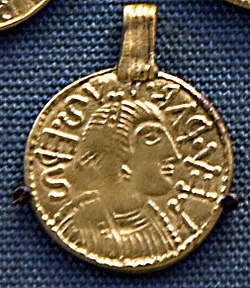
Augustine of Canterbury was a Christian monk who became the first archbishop of Canterbury in the year 597. He is considered the "Apostle to the English”.
Æthelberht was King of Kent from about 589 until his death. The eighth-century monk Bede, in his Ecclesiastical History of the English People, lists him as the third king to hold imperium over other Anglo-Saxon kingdoms. In the late ninth century Anglo-Saxon Chronicle, he is referred to as a bretwalda, or "Britain-ruler". He was the first English king to convert to Christianity.
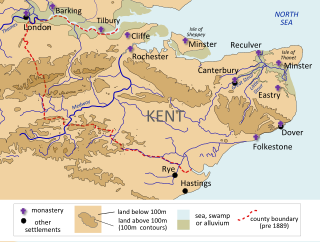
The Kingdom of the Kentish, today referred to as the Kingdom of Kent, was an early medieval kingdom in what is now South East England. It existed from either the fifth or the sixth century AD until it was fully absorbed into the Kingdom of Wessex in the late 9th century and later into the Kingdom of England in the early 10th century.

The Church of St Martin is an ancient Church of England parish church in Canterbury, England, situated slightly beyond the city centre. It is recognised as the oldest church building in Britain still in use as a church, and the oldest existing parish church in the English-speaking world, although Roman and Celtic churches had existed for centuries. The church is, along with Canterbury Cathedral and St Augustine's Abbey, part of a World Heritage Site.

Liudhard was a Frankish bishop.

The history of the English penny can be traced back to the Anglo-Saxon kingdoms of the 7th century: to the small, thick silver coins known to contemporaries as pæningas or denarii, though now often referred to as sceattas by numismatists. Broader, thinner pennies inscribed with the name of the king were introduced to Southern England in the middle of the 8th century. Coins of this format remained the foundation of the English currency until the 14th century.
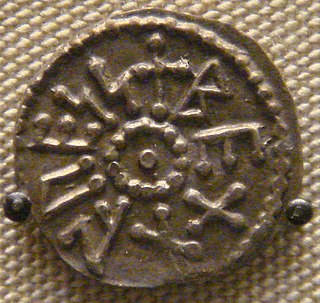
Beonna was King of East Anglia from 749. He is notable for being the first East Anglian king whose coinage included both the ruler's name and his title. The end-date of Beonna's reign is not known, but may have been around 760. It is thought that he shared the kingdom with another ruler called Alberht and possibly with a third man, named Hun. Not all experts agree with these regnal dates, or the nature of his kingship: it has been suggested that he may have ruled alone from around 758.

Charles Roach Smith, FSA, was an English antiquarian and amateur archaeologist who was elected a fellow of the Society of Antiquaries of London, and the London Numismatic Society. He was a founding member of the British Archaeological Association. Roach Smith pioneered the statistical study of Roman coin hoards.
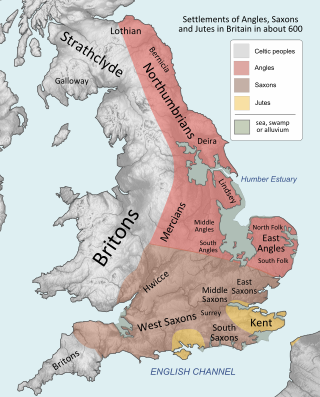
The Gregorian mission or Augustinian mission was a Christian mission sent by Pope Gregory the Great in 596 to convert Britain's Anglo-Saxons. The mission was headed by Augustine of Canterbury. By the time of the death of the last missionary in 653, the mission had established Christianity among the southern Anglo-Saxons. Along with the Irish and Frankish missions it converted Anglo-Saxons in other parts of Britain as well and influenced the Hiberno-Scottish missions to continental Europe.

Saint Bertha or Saint Aldeberge was the queen of Kent whose influence led to the Christianization of Anglo-Saxon England. She was canonized as a saint for her role in its establishment during that period of English history.
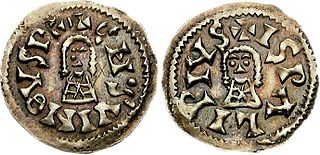
The coinage of the Visigoths was minted in Gaul and Hispania during the early Middle Ages, between the fifth century and approximately 710.
The Christianisation of Anglo-Saxon England was a process spanning the 7th century. It was essentially the result of the Gregorian mission of 597, which was joined by the efforts of the Hiberno-Scottish mission from the 630s. From the 8th century, the Anglo-Saxon mission was, in turn, instrumental in the conversion of the population of the Frankish Empire.

The Canterbury-St Martin's hoard is a coin-hoard found in the 19th century at Canterbury, Kent dating from the 6th century. The group, in the World Museum, Liverpool, consists of eight items, including three gold coins mounted with suspension loops for use as pendants. One of these is the Liudhard medalet, the earliest surviving Anglo-Saxon coin. Another coin is in the Bibliotheque Nationale.
The Forsbrook Pendant is a piece of Anglo Saxon jewellery found in Forsbrook, Staffordshire, England and sold to the British Museum in 1879. It is a 7th-century setting of a 4th-century gold Roman coin in gold cellwork with garnet and blue glass inlays.

Viking coinage was used during the Viking Age of northern Europe. Prior to the usage and minting of coins, the Viking economy was predominantly a bullion economy, where the weight and size of a particular metal is used as a method of evaluating value, as opposed to the value being determined by the specific type of coin. By the ninth century, the Viking raids brought them into contact with cultures well familiarised with the use of coins in economies of Europe, hence influencing the Vikings own production of coins.

The thrymsa was a gold coin minted in seventh-century Anglo-Saxon England. It originated as a copy of Merovingian tremisses and earlier Roman coins with a high gold content. Continued debasement between the 630s and the 650s reduced the gold content in newly minted coins such that after c. 655 the percentage of gold in a new coin was less than 35%. The thrymsa ceased to be minted after about 675 and was superseded by the silver sceat.

Marion MacCallum Archibald was a British numismatist, author and for 33-years a curator at the British Museum. She was the first woman to be appointed Assistant Keeper in the Department of Coins and Medals and is regarded as a pioneer in what had previously been a male-dominated field. Her 70th birthday was celebrated with the publication of a book of essays authored by 30 of her colleagues, collaborators and former students for whom Marion's name was "synonymous ... with the study of Anglo-Saxon coins at the British Museum".
The Beeston Tor Hoard is an Anglo-Saxon jewellery and coin hoard discovered in 1924 at Beeston Tor in Staffordshire. The hoard consists of forty-nine coins, two silver brooches with Trewhiddle style decoration, three finger rings, and miscellaneous fragments. The coins date the burial of the hoard to approximately 875 AD.
The Crondall Hoard is a hoard of coins and other articles that was found in the village of Crondall in the English county of Hampshire. The hoard was discovered in 1828 and is believed to date to the seventh century. It was the largest hoard of Anglo-Saxon gold coins found prior to the 21st century. The coins are now in the collection of the Ashmolean Museum at Oxford.
